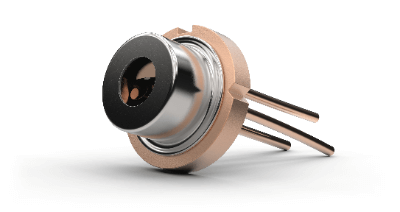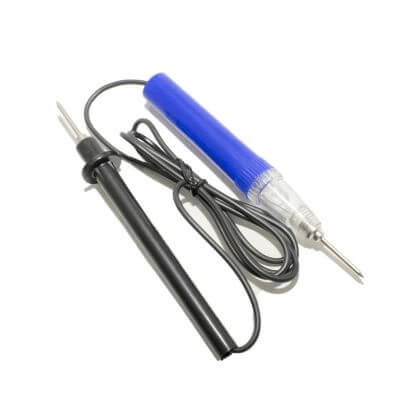¿Qué es un Diodo Láser?
 Un diodo láser es una luz que utiliza la emisión por recombinación de un semiconductor.
Un diodo láser es una luz que utiliza la emisión por recombinación de un semiconductor.
La emisión por recombinación se produce cuando un electrón y un hueco (agujero) se encuentran en la unión y la energía extra que tienen en común se convierte en luz. La luz de los diodos láser es una luz láser de una sola longitud de onda y alineada en fase, también conocida como láser semiconductor y descrita como LD.
El color de la luz láser de semiconductor viene determinado por los elementos constitutivos del semiconductor. Por ejemplo, el InGaN es de UV a verde (380-540 nm), el AlGaInP es rojo (620-700 nm) y el InGaAsP es IR. Los sustratos respectivos son “GaN” para InGaN, “GaAs” para AlGaInP e “InP” para InGaAsP.
Los LED emiten luz del mismo modo que los láseres semiconductores, pero la fase y el rango de longitudes de onda de la luz son más variados que en los láseres semiconductores. Esto significa que, a diferencia de los LED (diodos emisores de luz), los láseres de semiconductores emiten luz basándose en un principio conocido como “emisión inducida”, que permite emitir luz intensa con una fase bien definida.
Usos de los Diodos Láser
Los diodos láser se utilizan mucho en aparatos de consumo. La razón es su pequeño tamaño y la posibilidad de fabricarlos en serie, lo que reduce los costes de producción.
En equipos informáticos, los diodos láser se utilizan en lectores ópticos para unidades ópticas como CD, DVD y BD, fotocopiadoras, impresoras láser y equipos de comunicación basados en fibra óptica. Las aplicaciones de alta potencia incluyen marcadores láser y máquinas de procesamiento láser.
La naturaleza de la luz láser, resistente a la difusión y de gran alcance, también se ha utilizado en instrumentos de topografía y punteros láser para apuntar a objetos, y se ha generalizado junto con la miniaturización y la reducción de precio de los elementos láser semiconductores rojos de baja potencia.
Principio de los Diodos Láser
En los diodos láser, la luz se emite cuando los huecos (agujeros de electrones) y los electrones se recombinan bajo la aplicación de un voltaje.
El fotón emitido provoca que otro electrón se recombine con el hueco uno tras otro, emitiendo un fotón, de modo que la luz generada tiene la misma fase y longitud de onda. Como la longitud de onda de la luz es siempre constante, se utilizan en situaciones en las que se requiere una cantidad constante de luz, como los lectores de códigos de barras, los punteros láser y las comunicaciones por fibra óptica.
Más Información sobre los Diodos Láser
1. Especificaciones de los Diodos Láser
La curva L/I se utiliza para comprender las especificaciones de los diodos láser. Esta curva permite registrar la corriente de accionamiento suministrada en relación con la intensidad luminosa de salida.
Esta curva se utiliza para determinar el punto de funcionamiento (corriente de accionamiento a la salida de emisión nominal) y la corriente umbral (corriente de arranque del láser) en el láser, y también se utiliza para determinar la corriente necesaria para alcanzar una alta potencia de salida a una corriente determinada.
De la lectura de este diagrama de curvas se desprende que la salida óptica depende en gran medida de la temperatura y que, a medida que ésta aumenta, las características del láser también disminuyen. Esto permite visualizar y estimar la eficiencia del diodo láser mediante la incorporación de la curva L/I.
2. Diferencia entre los Diodos Láser y los Diodos Emisores de Luz
Los diodos emisores de luz se caracterizan porque la luz no está en fase y, por tanto, se difunde radialmente. En cambio, los diodos láser están en fase y, por tanto, producen un haz de luz lineal.
En los diodos emisores de luz, la capa emisora de luz tiene una gran superficie, lo que dificulta la entrada de la luz en una fibra pequeña con un sistema de núcleo pequeño. En cambio, los diodos láser tienen una capa de emisión estrecha, pero inciden fácilmente en fibras ópticas con sistemas de núcleo pequeño.
En los diodos láser, los fotones emitidos se desencadenan por la recombinación de huecos y electrones cuando se aplica una tensión, y otros electrones se recombinan con los huecos uno tras otro para emitir fotones (emisión inducida). La luz producida es, por tanto, de la misma fase y longitud de onda. En cambio, la luz generada por los diodos emisores de luz es de varias fases y longitudes de onda.
3. Vida Útil de los Diodos Láser
La vida media de un diodos láser depende del entorno de funcionamiento (temperatura de funcionamiento, electricidad estática, sobretensiones en el suministro eléctrico) y suele estimarse en 10.000 horas. Entre los factores ambientales que afectan a la esperanza de vida, aquí se analiza la temperatura de funcionamiento.
En primer lugar, el efecto de la temperatura de funcionamiento es que se dice que un aumento de 10°C en la temperatura de funcionamiento reduce la vida a la mitad, y si la temperatura sigue aumentando por encima de la temperatura máxima de funcionamiento, el potencial de daños en el diodo láser y la degradación del rendimiento a largo plazo se hace mayor. Por lo tanto, se recomienda utilizar disipadores de calor (placas radiantes) para disipar el calor del interior del producto hacia el exterior a fin de evitar en la medida de lo posible los efectos de la generación de calor.

